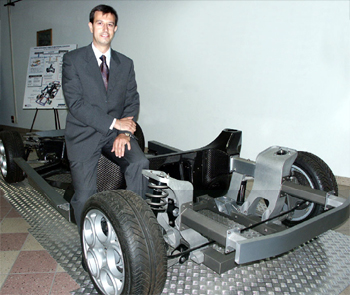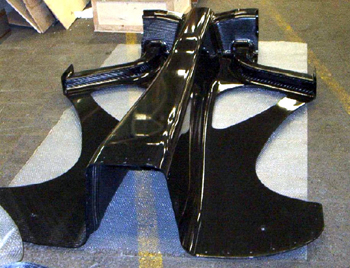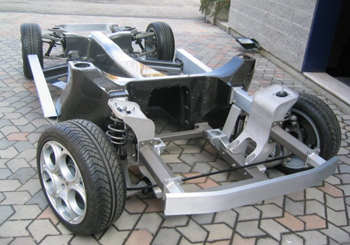|
12.09.2004
Further
details of the alfa romeo “Concept Sportiva Evoluta” project revealed |
||||||||||||||||||||||||
As part of the “Sportiva Evoluta” concept project, the Fiat Research Centre (CRF) has been busy with the development of a new multi-material chassis concept, focusing on the relationship between weight and power. Last August we brought you a first look at this exciting project. Now CRF have offered a glimpse at the power and performance that this chassis structure is capable of delivering, and it is exceptional. The main technical characteristics of the vehicle to which such a chassis will be fitted are summarised in the following table:
With the nature
of the chassis being a sports application, the choices of materials meet the
requirement for a high power to weight ratio. After detailed structural analyses
were conducted for vehicle rigidity, it was decided to use a composite carbon
fibre material for the main member. Two processes have been used in the manufacturing of the prototype chassis, which ensure a strong design capable of resisting the high forces imposed during high speed handling and crashes; “hand lay-up” manual lamination, and “RTM” resin transfer moulding. The main chassis is split into two parts, the bulkhead and backbone, which are connected by two rows of bolts.
Manual
lamination was used for the backbone member, using a sandwich type structure to
increase the strength whilst remaining light in weight. This solution consists
of two carbon-fibre sheets, between which an ultra low-density honeycomb panel
is inserted to improve rigidity characteristics. There are two disadvantages of the manual lamination process, the main one being the fact that it would only be possible to produce one to two cars a day. Although the initial investment for the process is very low, the high labour hours, and more specifically the need for skilled labour elevate the variable costs. The complex shape of the bulkhead section triggered the engineers at the CRF to explore the potentials of the RTM process. The RTM process uses a stamp, into which a glass-fibre mould is initially inserted. A resin matrix containing carbon fibres is subsequently pumped in under a controlled pressure and temperature. To increase the structural characteristics of the member, a reinforcing material called Nomex was also used. An economic analysis of the RTM process was also carried out during the project, and demonstrated that the high convenience of the technology would allow for a production figure of between 5 to 10 cars a day. The chassis design for this project was developed entirely using the latest technology available in CAD, and has enabled the concept of a composite material chassis to be produced in reality.
This totally new method of chassis
construction will launch Alfa Romeo into the genuine sportscar category. In the
power-to-weight ratio stakes, it approaches the very definition of the pursuit
of that aim: the Lotus Elise. A successful outcome for CRF's engineer's. by Paddy Granger
|
|
|||||||||||||||||||||||


